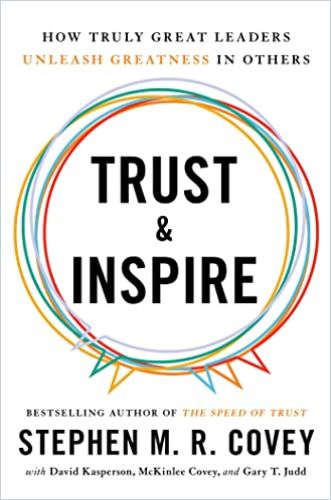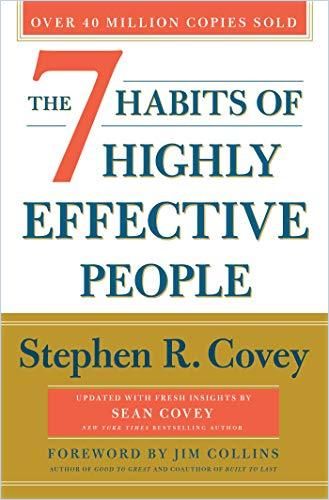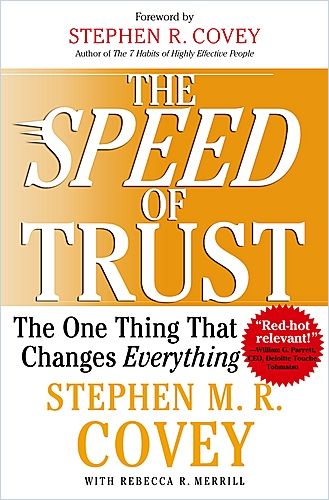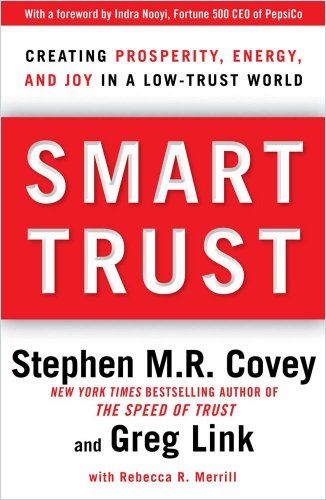“People Don’t Want to Be Merely Motivated – They Seek Inspiration.”

Stephen, for decades you have been dealing with trust in organizations and companies. You built your authorship around it and advised many successful executives and managers. Looking back, how has the debate evolved over the years? And why is the keyword “trust” booming again right now?
Stephen M.R. Covey: I think we have far more awareness of the importance of trust now that we’re navigating to a new world of work, because its rules and models are yet to be determined. What’s already clear is that they differ depending on people and organizations, and they may change from company to company, department to department, individual agreement to agreement. It’s like Satya Nadella, the CEO of Microsoft, said: “Organizations run on trust.” And no matter what solution someone comes up with when reorganizing the ways of collaboration within an organization, if there’s low trust, it doesn’t work as well – and it doesn’t feel as good. On the other hand, if there’s high trust, it opens you up to many yet unrecognized possibilities. In 2022, after the COVID-19 pandemic, we’re just more aware that trust has become a new currency.

So, it’s a lubricant easing change processes, and the COVID-19 pandemic, which unsettled so many people, only made that clear to us?
Exactly. Change happens at the speed of trust. And the external shock of the pandemic made clear that trust multiplies and amplifies everything good you’re trying to do. Yet, distrust will tax everything you’re trying to do.
In his modern classic The 7 Habits of Highly Effective People, your father promoted trust as a leadership virtue – and described it as essential for successful collaboration. So why do we still need to educate leaders about this today, 30 years later?
To a certain extent, the French proverb, “Fish discover water last” puts it best: We are so immersed in it that we’re kind of unaware of it.
We often don’t recognize trust until we lose it. It’s like air. You don’t notice air. But take it away, and you’ll notice immediately.
Stephen M.R. Covey
That’s one thing, and it’s about our daily connections. The second thing is that we live in a world of declining trust beyond these bonds. There is a growing gap between the trust that we have that surrounds our trusted friends and us, colleagues, organizations and social systems, and the world out there, where we cannot see through or directly affect the wheels that keep turning.

War, economic crisis, political polarization – we wouldn’t be talking about trust if we already had it everywhere. So, people feel that gap and want to broaden their belonging; they believe building trust is the right thing. But they don’t know how to create it on purpose. For many, it’s like trust is just an outgrowth, a by-product of human connections.
“You either have it, or you don’t.”
Exactly. But that’s not true. Trust is a learnable skill. Trust is a competency. It’s something that we can create on purpose. We can build it, we can grow it, we can establish it and we can expand it. That’s why, in my first book, The Speed of Trust, there are 27 chapters, and only two of them explain trust while 25 explain how to build trust – and why it unleashes the full potential of you and your peers.

So, for all who don’t know your books on trust, the elevator pitch, please: Why should I trust more instead of control more?
Let me put it into three main categories: performance, personal development and well-being. First: Yes, it’s true that if you trust more instead of controlling more, you’ll get better performance, results and outcomes – not by a little, but by a lot. Overwhelming data and studies back my point. Take shareholder value: High-trust organizations outperform low-trust organizations by about three times in total return to shareholders. Take innovation: You’re 11 times more likely to innovate in a high-trust culture than a low-trust culture. Or, take retention:
Millennials, the majority of today’s workforce, are 23 times more likely to stay with a company with a high-trust culture than in companies with a low-trust culture. It’s not two times. It’s 23 times!
Stephen M.R. Covey
Every HR manager should know this figure and the positive impact of trust on all other performance indicators.
How about the level of personal development?
Almost every performance measure I can look at is better in high-trust organizations. Trust increases the capabilities and capacity of your team and your organization of your people. When they’re trusted and given opportunities, they grow, they develop, and the organization develops future capacity with them. So, if your people grow thanks to a solid trust culture and for the same reason prefer to stay with you rather than offer their new capacities and skills elsewhere, you’ll have a massive advantage over all your competitors in the battle for talent.
Take-Aways
- Almost every performance measure is better in high-trust organizations.
- Trust is a learnable skill. Trust is a competency. It’s something that we can create on purpose.
- Motivation is extrinsic, and inspiration is intrinsic. So inspiring leaders try to light the fire within instead of just moving people through rewards.
Let’s discuss this a little before we deal with well-being: As a job applicant, how can you tell if an employer is serious about a culture of trust?
I think you want to look at two things. First, are they trustworthy? That’s very important. To get an impression, look for the integrity, the honesty of their doing and their communication. Also, look at their framework of corporate governance and their transparency policy. What is their ethical standing, and what problems do they solve – or do they generate new issues? Second, are they trusting? Find out their policies and procedures. Do they show that they trust their people? Are people being micromanaged? What does their rulebook look like? How thick is it? If there is a lot of bureaucracy already visible, you can be sure that the level of trust within the company is relatively low. As an applicant, you should ask about such indicators because they matter to you, and you want both.
Should they actively ask about such internals when invited for a job interview?
Of course! You can decently wrap it around expectations and accountability. Ask questions about the hybrid work arrangements, for example, to find out how much the company trusts its employees. Or something like, “Can you please tell me about the process of empowering your employees? How are they held accountable for what they’re doing?” Or, “Please, tell me more about the agreements you set up with your employees that empower them so that they deliver results in a way that you want, but also they have the autonomy that they want in a way that works for both.” That shows them that you are an engaged applicant for whom trust matters.
So, it makes little sense to increase surveillance and monitoring via digital tools and, at the same time, emphasize how much you trust your people.
Companies working this way shout out loud that they don’t fully trust their people.
Surveillance is a tool you use out of distrust.
Stephen M.R. Covey
To get better results for everyone involved, including the outcomes that the companies want, focus on two things. First: Build a stewardship agreement with individual employees around expectations and build accountability into those expectations. This step is transparent, a basis for control for both involved, and it ideally generates a cycle of trust between them. Second: Focus on building a high-trust culture within your entire company and let the culture do the job of controlling. Those who tend to “freeride” in high-trust cultures are much faster identified and removed than in low-trust surveillance bureaucracies.
Why?
It’s like on my lawn. [Laughs.] I wanted grass, and I got weeds coming up everywhere. So, I got weed spray to get rid of the weeds. My neighbor watched me and said, “Stephen, that’s not the best way. You’ll put the spray here, but the weed will pop up over there, and so on… Your problem is your lawn.” And he was right: A healthy lawn crowds out the weeds. And it’s the same with a high-trust culture. Surveillance, even if you call it a “productivity tool,” is like weed spray: All you’re doing is spraying from one to another to another, but you’re not solving the real problem.
So, instead of re-installing old micromanagement tools in new digital dresses, build a healthy culture of trust.
Stephen M.R. Covey
It is a reinforcer of the kind of behavior you want. And it leads back to the third point regarding the advantages of trusting over controlling.

Right. So, what is it?
In high-trust cultures, employees are more productive and innovative, but they also have far greater well-being. Studies show that they are more satisfied with life, take fewer sick days and experience 74% less stress. You can also reduce risks for burnout and some other stress-induced diseases. These facts are a significant contribution to one of the main challenges in the post-pandemic workplace and on the way to sustainable hybrid forms of collaboration where no one should be left behind.
You already touched on the topic, but I think it’s worth highlighting that many people currently have problems with self-trust: Two years ago, only a few people knew about Imposter Syndrome – now, we all know the term. What if you can’t trust yourself? How can you trust others then?
It helps if you distinguish between the character and competence side. Imposter syndrome usually is about the competence side: “Gosh, I got this new job, and I don’t know what I’m doing – and even get better paid for it!” In most of these cases, you can gain that competence over time. In a broader sense, it’s a learning matter, and you’ll get there at some point. On the character side, however, self-trust is the foundation on which all other trust begins, and it’s an inside-out process. In his famous masterpiece Faust, the German writer Johann Wolfgang von Goethe put it best: “As soon as you trust yourself, you will know how to live.” This also applies to your role in the workplace: The only way we will sustain trust with our customers and partners is if we have high confidence on the inside, with our people and our teams. So, it ultimately comes back to every individual looking in the mirror and starting with themselves. Do I trust myself? Do I give my team a teammate they can trust, a leader they can trust? Is it wise to trust me? And then it ripples out from there.
And if it does not, because you can’t?
If you don’t trust yourself, the whole process becomes challenging. Because you always wonder and question, “Can they do this? Are they capable? Are they honest?” But if you factually lack integrity, are dishonest and don’t care about people – you tend to project that out onto everybody else, destroying trust.
Can you think of an example?
Unfortunately, there are many examples. Just recently, a company I advise stopped working with another company. One side always wanted to consider all contingencies, and the other wanted to move forward. Well, crap runs downhill: The company that always wanted new rules and formalities had a CEO everyone knew had only got to the chair because he lied, cheated and deprived others of the fruits of their labor. He didn’t trust anyone because he assumed that others wouldn’t deal with him differently. As a result, in the company’s project teams, people didn’t trust each other either – and of course, they didn’t trust their “partners” in business. Value was destroyed, inspirational ideas were drowned – it was a traumatic experience.
In your new book, Trust & Inspire, inspiration comes into full play. What is its connection to trust?
As the example with the two companies shows, it’s not enough to be trustworthy; it’s necessary but insufficient. As a leader, you also need to be trusting. Because extending trust to others is the basis for them to return it to you. And that is when you’re starting to inspire people. It tends to bring out the best in you when someone believes in you and has confidence in you; when someone takes a chance on you. Not only do you tend to rise to the occasion, but you are also inspired to prove it, justify it, you want to pay it back and perform better. To be trusted is the most inspiring form of human motivation. The Latin “inspirare” means “to breathe life into” something.
That’s what inspiring leaders need to do: Breathe life into people, relationships, teams and cultures.
Stephen M.R. Covey
So, you say: No need to supply it, ignite it in people? This way, motivation is no longer extrinsic, as it is in classic leadership literature.
Motivation is extrinsic, and inspiration is intrinsic – inside of people. So inspiring leaders try to light the fire within instead of just moving people somewhere through external stimuli, through rewards. Because, yes, short-term carrot and stick may motivate people to do something, but – as studies show – it primarily motivates them to get more rewards, which tends to be much less innovative, productive and fulfilling than classic leadership advice admits.
So, inspiration is “purpose put into action?”
Yes, and that is what people want. In a study by Jack Zenger and Joe Folkman, they looked at 16 leadership competencies. They asked people, “What is the number one competency you want in your leader?” And the answer that came back was, “A leader who inspires me.” People don’t want to be merely motivated – they seek inspiration. And they follow those who inspire because it generates a sense of desire, not fear.
And you can learn that as a leader, even as a command-and-control type of guy?
You can! Too often, inspiration and charisma are equated as if they were the same, and the latter is a given blessing. They’re not:
Inspiring others is a learnable skill, and it likely happens when you model certain stewardship.
Stephen M.R. Covey
First: Show humility. According to recent studies, leaders who model humility are 18 times more likely to inspire those around them than leaders who don’t. Second: Care. That means you must establish a certain sense of belonging and connection – by connecting people and connecting them to purpose and meaningful contribution. Then, inspiration follows. And your employees start their growth journey, stay loyal to your company, and possibly even become 125% more productive while enjoying higher well-being at the same time.
About the Author
Stephen M.R. Covey is CEO of CoveyLink Worldwide and the author of the New York Times bestseller The Speed of Trust. He is the son of the late Stephen R. Covey, author of The 7 Habits of Highly Effective People.







